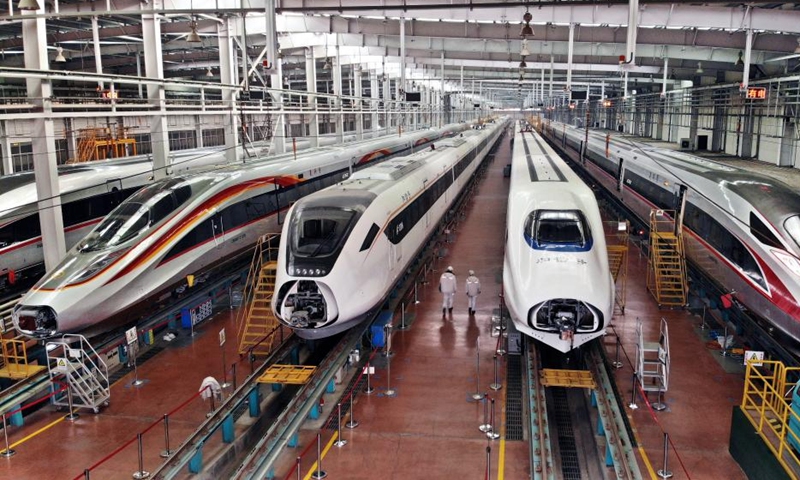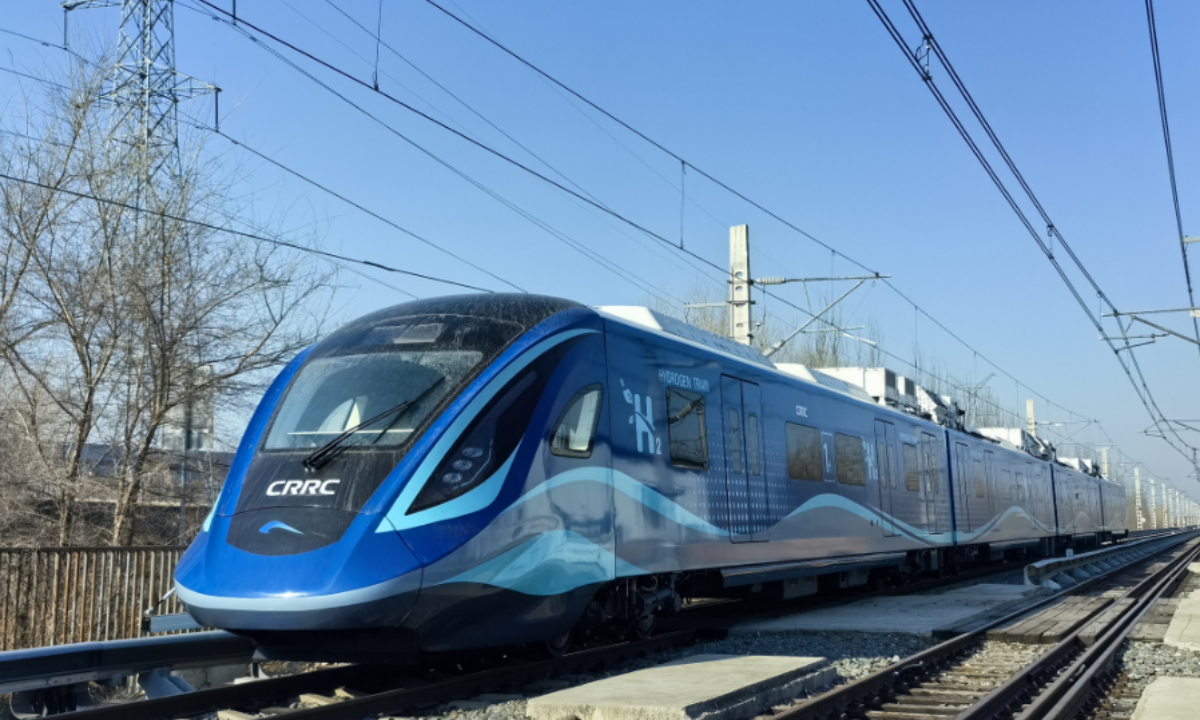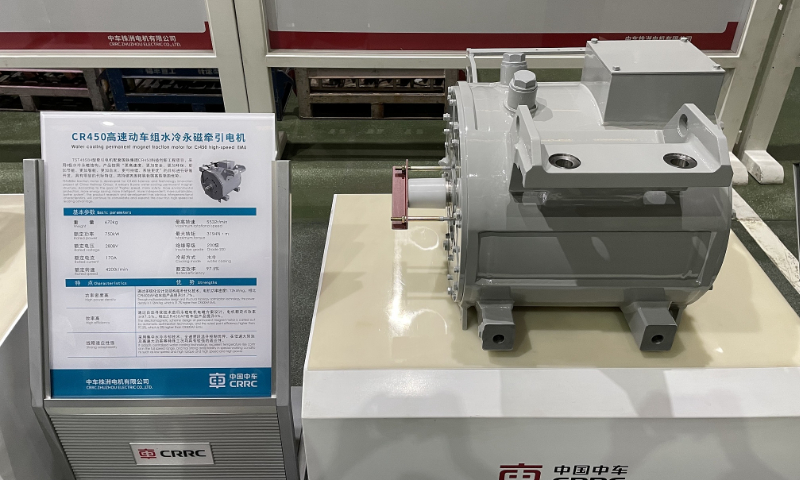Employee training programs set foundation for meteoric rise of China's manufacturing sector
Editor's Note:
With the global economy, including China's, facing challenges, some Western politicians and media outlets have stepped up smear campaigns against the world's second-largest economy. They selectively highlight information and distort facts to promote their narratives like "Peak China," while ignoring China's economic resilience and growth potential. To set the record straight, the Global Times is launching a multimedia project featuring in-depth articles, analyses and visual arts to provide a balanced and accurate portrayal of the Chinese economy. This is the 16th installment of the series.
Training highly skilled workers is of great significance for China's manufacturing sector take-off, allowing the world's manufacturing hub to adapt to the needs of new industrialization in order to fulfill the goal of Chinese modernization at an early date.
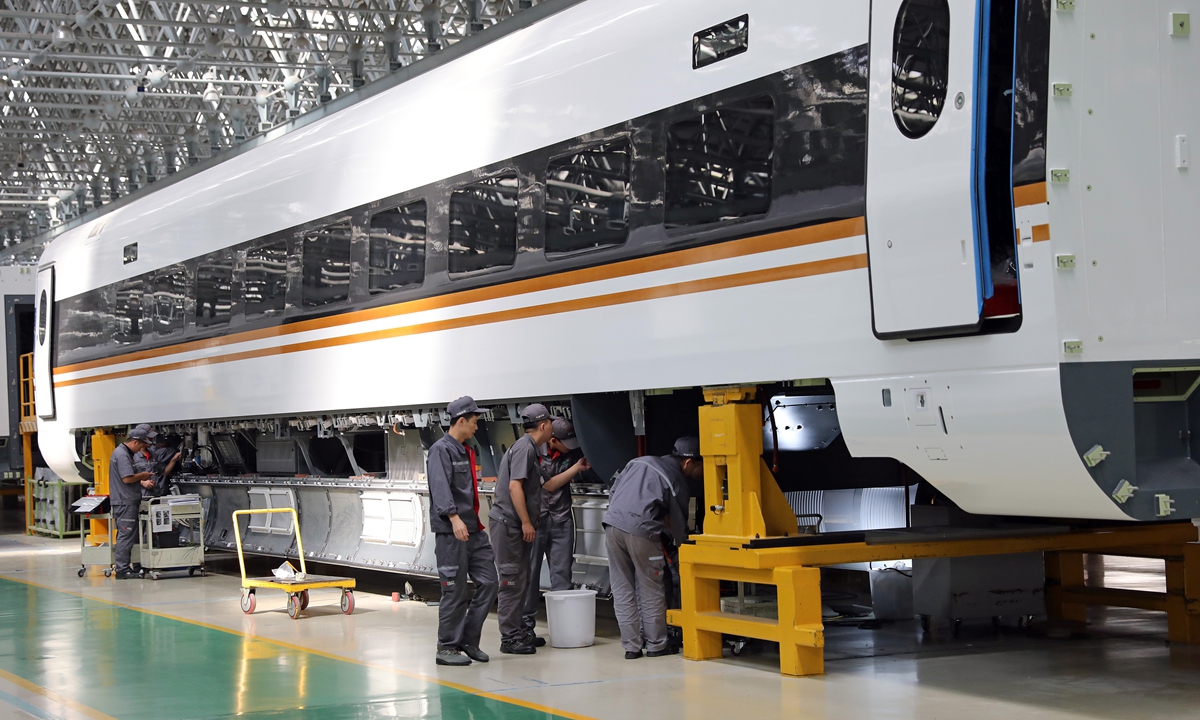
A set of important guidelines issued by the Communist Party of China Central Committee and the State Council on October 21 stated that China aims to foster 2,000 national-level master artisans, 10,000 provincial-level master artisans, and 50,000 city-level master artisans who possess advanced working skills by 2035 through deepening reforms in the building of China's high-caliber workforce.
The Chinese government will persistently promote modern vocational education, ramp up efforts to foster talent with comprehensive skills, and refine a lifelong vocational skills training system for the country's vast industrial workers, in order to cultivate urgently needed talent for the development of new quality productive forces and the promotion of high-quality economic and social development.
The Global Times recently paid a visit to a number of manufacturing plants and research institutes of CRRC Changchun Railway Vehicles Co, located in Changchun, capital of Northeast China's Jilin Province, to see how the grooming of skilled workers and engineers is being done at the grass-root level.
Skilled professionals
Inside the spacious, shaded, historic plant of CRRC Changchun Railway Vehicles Co, rows of workshops are arranged like a chessboard with heavy-haul trucks occasionally transporting finished parts and components among them. The factory is responsible for manufacturing key parts of the bullet train that already form China's 4,300-kilometer-long network of high-speed trains.
At CRRC, there are more than 83,700 skilled professionals, and 70 percent of them are classified as highly skilled workers.
Inside one of the workshops, welders were seen busy welding and polishing parts for rolling stock, and Li Wanjun, a national-level master artisan, leads a Model Innovation Studio within the workshop. Li is one of the plant's legendary figures and the holder to a long list of certificates of commendation that have occupied the entire wall of his office.
There are 10 such master studios within CRRC Changchun, each with around 30 technical members specializing in specific skills.
Li, whose 34 years of frontline working experience has made him a master welder, told the Global Times that the recognition given to skilled industrial workers by the country, its leadership, and the company is beyond his imagination.
At the times of the Global Times visit, young workers from various subsidiary units of CRRC, the Chinese high-speed train manufacturer, are gathering in Changchun for a skill contest for six common occupations including riveter, forklift driver, welder and two other unique occupations.
"Our test tracks workers' true abilities," said Li, who for his outstanding achievement is appointed the referee for the welding competition.
"Each contestant will have eight hours to weld a steel box with tubes running inside it, and all the required skills are needed - such as welding with face up and sideways - for a bullet train welder in practical work."
"But above all, I think the contest is a platform for young workers to meet with each other, gauge their careers' great potential, and teach them that doing their work well is not temporary business, which actually requires life-long devotion," Li said.
The Workshops provided by national-level artisans like Li serve as in-house training units, and over the years they have provided training sessions to more than 20,000 trainees, supplying the fast-developing bullet train manufacturing business with qualified talent, according to CRRC Changchun.
Li noted that he could always find himself "spurred and inspired" by the encouragement from the state, the government, and company leadership.
"The further improvement of China's bullet train systems put higher demands for the technical workers to grasp more techniques, and I am always amazed that our company's leadership could always come up with new honorary titles and good incentives for us, once we have surmounted the difficulties," Li said.
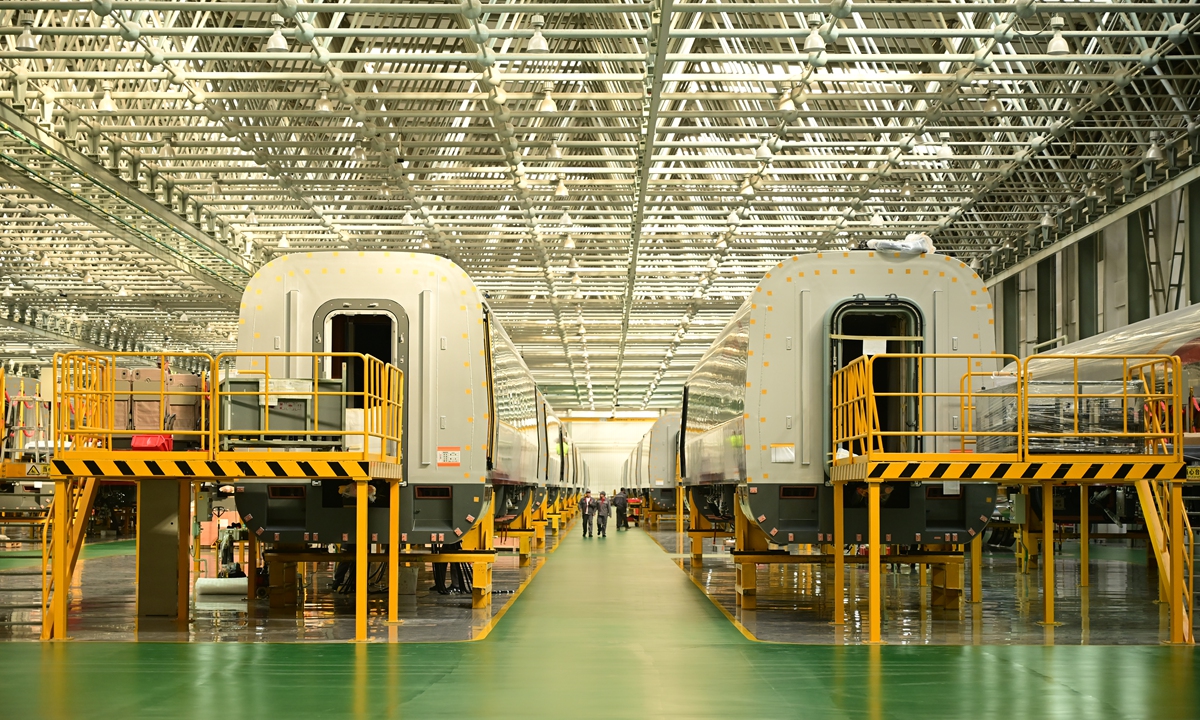
Industrial pioneers
Chinese President Xi Jinping has encouraged industrial workers to further contribute wisdom and strength to building a country that is strong in manufacturing and promoting the full revitalization of Northeast China in a reply letter to representatives of workers from China First Heavy Industries Co, a leading equipment manufacturer headquartered in Qiqihar city, Northeast China's Heilongjiang Province, Xinhua News Agency reported on September 28.
Manufacturing is the foundation of a country and the basis of a strong nation, Xi said, expressing his hope that the workers adhere to the original intention of serving the country with skills and promote the spirit of model workers and craftsmanship.
China has become a global leader in making high-speed train systems in the world, and Chinese scientists, engineers, and workers have supported the bullet train program, represented by those in CRRC's subsidiary companies scattered in the country.
In recent years, they have successfully added bullet trains with a top operational speed of 350 kilometers per hour that suit the icy and snowy conditions in northern provinces of China and engaged in earlier phase research work for hydrogen-powered trains and state-of-art maglev trains too.
Liu Junyang, in his 30s, is a senior engineer at CRRC Changchun. Liu is behind the design work for Fuxing bullet trains that can travel in icy and snowy conditions.
Liu said the successful rollout of bullet trains suitable to extreme low temperatures has ensured the success of Beijing 2022 Winter Olympics, and facilitated the rapid development of winter sports in recent years as HSR channel more people to winter resorts in the country.
"There is no government in the world that invests so lavishly in HSR like ours. As a result, the people have benefited greatly," Liu said.
With the global economy, including China's, facing challenges, some Western politicians and media outlets have stepped up smear campaigns against the world's second-largest economy. They selectively highlight information and distort facts to promote their narratives like "Peak China," while ignoring China's economic resilience and growth potential. To set the record straight, the Global Times is launching a multimedia project featuring in-depth articles, analyses and visual arts to provide a balanced and accurate portrayal of the Chinese economy. This is the 16th installment of the series.
Training highly skilled workers is of great significance for China's manufacturing sector take-off, allowing the world's manufacturing hub to adapt to the needs of new industrialization in order to fulfill the goal of Chinese modernization at an early date.

Workers at the workshop of CRRC Changchun assemble a bullet train. Photo: IC
A set of important guidelines issued by the Communist Party of China Central Committee and the State Council on October 21 stated that China aims to foster 2,000 national-level master artisans, 10,000 provincial-level master artisans, and 50,000 city-level master artisans who possess advanced working skills by 2035 through deepening reforms in the building of China's high-caliber workforce.
The Chinese government will persistently promote modern vocational education, ramp up efforts to foster talent with comprehensive skills, and refine a lifelong vocational skills training system for the country's vast industrial workers, in order to cultivate urgently needed talent for the development of new quality productive forces and the promotion of high-quality economic and social development.
The Global Times recently paid a visit to a number of manufacturing plants and research institutes of CRRC Changchun Railway Vehicles Co, located in Changchun, capital of Northeast China's Jilin Province, to see how the grooming of skilled workers and engineers is being done at the grass-root level.
Skilled professionals
Inside the spacious, shaded, historic plant of CRRC Changchun Railway Vehicles Co, rows of workshops are arranged like a chessboard with heavy-haul trucks occasionally transporting finished parts and components among them. The factory is responsible for manufacturing key parts of the bullet train that already form China's 4,300-kilometer-long network of high-speed trains.
At CRRC, there are more than 83,700 skilled professionals, and 70 percent of them are classified as highly skilled workers.
Inside one of the workshops, welders were seen busy welding and polishing parts for rolling stock, and Li Wanjun, a national-level master artisan, leads a Model Innovation Studio within the workshop. Li is one of the plant's legendary figures and the holder to a long list of certificates of commendation that have occupied the entire wall of his office.
There are 10 such master studios within CRRC Changchun, each with around 30 technical members specializing in specific skills.
Li, whose 34 years of frontline working experience has made him a master welder, told the Global Times that the recognition given to skilled industrial workers by the country, its leadership, and the company is beyond his imagination.
At the times of the Global Times visit, young workers from various subsidiary units of CRRC, the Chinese high-speed train manufacturer, are gathering in Changchun for a skill contest for six common occupations including riveter, forklift driver, welder and two other unique occupations.
"Our test tracks workers' true abilities," said Li, who for his outstanding achievement is appointed the referee for the welding competition.
"Each contestant will have eight hours to weld a steel box with tubes running inside it, and all the required skills are needed - such as welding with face up and sideways - for a bullet train welder in practical work."
"But above all, I think the contest is a platform for young workers to meet with each other, gauge their careers' great potential, and teach them that doing their work well is not temporary business, which actually requires life-long devotion," Li said.
The Workshops provided by national-level artisans like Li serve as in-house training units, and over the years they have provided training sessions to more than 20,000 trainees, supplying the fast-developing bullet train manufacturing business with qualified talent, according to CRRC Changchun.
Li noted that he could always find himself "spurred and inspired" by the encouragement from the state, the government, and company leadership.
"The further improvement of China's bullet train systems put higher demands for the technical workers to grasp more techniques, and I am always amazed that our company's leadership could always come up with new honorary titles and good incentives for us, once we have surmounted the difficulties," Li said.

The scene of CRRC Changchun's assembling plant on October 16, 2024 Photo: Tao Mingyang/GT
Industrial pioneers
Chinese President Xi Jinping has encouraged industrial workers to further contribute wisdom and strength to building a country that is strong in manufacturing and promoting the full revitalization of Northeast China in a reply letter to representatives of workers from China First Heavy Industries Co, a leading equipment manufacturer headquartered in Qiqihar city, Northeast China's Heilongjiang Province, Xinhua News Agency reported on September 28.
Manufacturing is the foundation of a country and the basis of a strong nation, Xi said, expressing his hope that the workers adhere to the original intention of serving the country with skills and promote the spirit of model workers and craftsmanship.
China has become a global leader in making high-speed train systems in the world, and Chinese scientists, engineers, and workers have supported the bullet train program, represented by those in CRRC's subsidiary companies scattered in the country.
In recent years, they have successfully added bullet trains with a top operational speed of 350 kilometers per hour that suit the icy and snowy conditions in northern provinces of China and engaged in earlier phase research work for hydrogen-powered trains and state-of-art maglev trains too.
Liu Junyang, in his 30s, is a senior engineer at CRRC Changchun. Liu is behind the design work for Fuxing bullet trains that can travel in icy and snowy conditions.
Liu said the successful rollout of bullet trains suitable to extreme low temperatures has ensured the success of Beijing 2022 Winter Olympics, and facilitated the rapid development of winter sports in recent years as HSR channel more people to winter resorts in the country.
"There is no government in the world that invests so lavishly in HSR like ours. As a result, the people have benefited greatly," Liu said.

